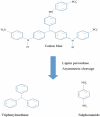A critical review on advances in the practices and perspectives for the treatment of dye industry wastewater
- PMID: 33356799
- PMCID: PMC8806354
- DOI: 10.1080/21655979.2020.1863034
A critical review on advances in the practices and perspectives for the treatment of dye industry wastewater
Abstract
Rapid industrialization has provided comforts to mankind but has also impacted the environment harmfully. There has been severe increase in the pollution due to several industries, in particular due to dye industry, which generate huge quantities of wastewater containing hazardous chemicals. Although tremendous developments have taken place for the treatment and management of such wastewater through chemical or biological processes, there is an emerging shift in the approach, with focus shifting on resource recovery from such wastewater and also their management in sustainable manner. This review article aims to present and discuss the most advanced and state-of-art technical and scientific developments about the treatment of dye industry wastewater, which include advanced oxidation process, membrane filtration technique, microbial technologies, bio-electrochemical degradation, photocatalytic degradation, etc. Among these technologies, microbial degradation seems highly promising for resource recovery and sustainability and has been discussed in detail as a promising approach. This paper also covers the challenges and future perspectives in this field.
Keywords: Industrial process; advanced wastewater treatments; dye industry wastewater; microbial degradation; resource recovery; waste generation.
Conflict of interest statement
No potential conflict of interest was reported by the authors.
Figures
Similar articles
-
Progress in membrane distillation processes for dye wastewater treatment: A review.Chemosphere. 2024 Jul;360:142347. doi: 10.1016/j.chemosphere.2024.142347. Epub 2024 May 15. Chemosphere. 2024. PMID: 38759802 Review.
-
A review on existing and emerging approaches for textile wastewater treatments: challenges and future perspectives.Environ Sci Pollut Res Int. 2024 Jan;31(2):1748-1789. doi: 10.1007/s11356-023-31175-3. Epub 2023 Dec 6. Environ Sci Pollut Res Int. 2024. PMID: 38055170 Review.
-
Recent advances based on the synergetic effect of adsorption for removal of dyes from waste water using photocatalytic process.J Environ Sci (China). 2018 Mar;65:201-222. doi: 10.1016/j.jes.2017.03.011. Epub 2017 Mar 17. J Environ Sci (China). 2018. PMID: 29548392 Review.
-
Application of polyaniline-based adsorbents for dye removal from water and wastewater-a review.Environ Sci Pollut Res Int. 2019 Feb;26(6):5333-5356. doi: 10.1007/s11356-018-3990-y. Epub 2019 Jan 5. Environ Sci Pollut Res Int. 2019. PMID: 30612350 Review.
-
Treatment of wastewater from petroleum industry: current practices and perspectives.Environ Sci Pollut Res Int. 2020 Aug;27(22):27172-27180. doi: 10.1007/s11356-019-04725-x. Epub 2019 Mar 13. Environ Sci Pollut Res Int. 2020. PMID: 30868465 Review.
Cited by
-
Lignocellulolytic Biocatalysts: The Main Players Involved in Multiple Biotechnological Processes for Biomass Valorization.Microorganisms. 2023 Jan 8;11(1):162. doi: 10.3390/microorganisms11010162. Microorganisms. 2023. PMID: 36677454 Free PMC article. Review.
-
Biodegradation of pharmaceuticals in photobioreactors - a systematic literature review.Bioengineered. 2022 Feb;13(2):4537-4556. doi: 10.1080/21655979.2022.2036906. Bioengineered. 2022. PMID: 35132911 Free PMC article.
-
Diatom microalgae as smart nanocontainers for biosensing wastewater pollutants: recent trends and innovations.Bioengineered. 2021 Dec;12(2):9531-9549. doi: 10.1080/21655979.2021.1996748. Bioengineered. 2021. PMID: 34709977 Free PMC article. Review.
-
Biotechnological potential of salt tolerant and xerophilic species of Aspergillus.Appl Microbiol Biotechnol. 2024 Nov 19;108(1):521. doi: 10.1007/s00253-024-13338-5. Appl Microbiol Biotechnol. 2024. PMID: 39560743 Free PMC article. Review.
-
Microbial mediated degradation of azo dyes from textile effluents is associated with the production of extracellular polysaccharides.Folia Microbiol (Praha). 2025 Aug 15. doi: 10.1007/s12223-025-01309-w. Online ahead of print. Folia Microbiol (Praha). 2025. PMID: 40813508
References
-
- Das A, Dey A.. P-Nitrophenol-Bioremediation using potent Pseudomonas strain from the textile dye industry effluent. J Environ Chem Eng. 2020;8(4):103830.
-
- Varjani SJ, Upasani VN.. Critical review on biosurfactant analysis, purification and characterization using rhamnolipid as a model biosurfactant. Bioresour Technol. 2017;232:389–397. - PubMed
-
- Rajkumar D, Kim J. Oxidation of various reactive dyes with in situ electro-generated active chlorine for textile dyeing industry wastewater treatment. J Hazard Mater. 2006;136(2):203–212. - PubMed
Publication types
MeSH terms
Substances
LinkOut - more resources
Full Text Sources
Other Literature Sources




